|
HOME: www.hiltonpond.org |
|||
|
SITTIN' ON THE DOCK OF THE POND, Back in the early 1990s we decided we sometimes wanted access to the depths of Hilton Pond without getting wet, so we constructed a long pier that jutted into the impoundment. From there we could look down at schools of Mosquitofish and watch Largemouth Bass and Bluegills as they patrolled their beds on the pond floor. To the pier we tied a large floating raft that allowed us to paddle across placid waters; this worthy craft comes in quite useful in spring when we want to check contents of several Wood Duck boxes. (We also erected on the pier a tall pole topped with 12 plastic gourds for Purple Martins that, alas, have never accepted our free lodging invitation.) We've spent many a pleasant hour standing on our wooden pier just soaking up sounds and sights around us--clouds of dragonflies patrolling the pond margin, Muskrats swimming along with only their eyes and snout out of water, a chorus of frogs trilling back and forth--but after all that standing and watching and listening we finally wised up last year and built a wooden bench at pier's end. Now we can sit and actually relax during our observations, sometimes making up new words to an old song by the late Otis Redding: "Sittin' on the dock of the pond . . . watchin' nature roll away."
All text & photos © Hilton Pond Center The bench on the pier (above) came in especially handy for sittin' and watchin' this week at Hilton Pond Center, for nowadays it provides our only unobstructed view of the sky. When we purchased our 11 acres back in 1982 they were wide open but through the wonders of vegetative succession Mother Nature has reclaimed this old farm and converted it to young woodland. Today, a widespread canopy of mixed hardwoods and pines blocks out the sun and makes us hustle toward the pier or pond margins if we want to view anything flying overhead. Although we didn't plan it that way the pier points to the northeast, so when we're seated on the bench in autumn we're facing the direction from which many migratory birds come. We like to watch for these migrants--particularly during the first half of September when good numbers of Common Nighthawks historically have flown over the Center. Even though Hilton Pond is not on a major flyway, in the late 1980s it was fairly common to see dozens of nighthawks flapping overhead in any given evening in early September, but through the past decade we've been lucky to see two or three per night. Most observers say the species is in steep decline. Our first attempt this year to see Common Nighthawks, Chordeiles minor, came at about 6:15 p.m. on 7 September as we went out to sit on the Hilton Pond pier with camera and telephoto lens. While we looked for nighthawks other kinds of birds passed over: A trio of Blue Jays, the occasional Fish Crow with its distinctive nasal call, speedy Mourning Doves, even a couple of Ruby-throated Hummingbirds that flew circles around each other and showed their innate aggressiveness even when not on breeding territories. As dusk came closer Common Grackle flocks grew from a few birds to several dozen and even a hundred in one grouping. All those jays, grackles, and crows were going in a northwesterly direction, so they likely were headed for a night roost rather migrating.
All text & photos © Hilton Pond Center We're pleased to report that right at 6:30 p.m. we saw our first Common Nighthawks (female, above, based on small white wing patches)--a group of five moving speedily toward the southwest, apparently not taking time to divert to feed. These graceful flyers are quite distinctive with bold white stripes across each wing. Nighthawks, of course, aren't hawks at all but are related to Whip-poor-wills and Chuck-wills-widows in the Goatsucker Family (Caprimulgidae)--so named because folklore has it they used their incredibly broad mouths to steal milk from goats. Instead the nighthawk's big gape provides an efficient way to capture insects on the wing. ( After the initial group of five nighthawks passed over Hilton Pond at 6:30 p.m. we spotted two at 6:50 p.m., and then eight more over the next 40 minutes before quitting at 7:30 p.m. This total of 15 birds is the most we've seen in a long time and gave us hope that Common Nighthawks may survive as a species after all. Their biggest challenge after this week will be navigating the long migratory route between the Carolina Piedmont and wintering grounds in South America as far away as Argentina.
All text & photos © Hilton Pond Center From our observation spot on the pier we saw one other really big bird fly directly overhead in the waning light. It bore pristine white plumage, had long black legs and a yellow-orange bill, and flew with its neck pulled in. There was no question this was a Great Egret, so with telephoto lens at the ready we fired off several exposures in succession, hoping for a good one. When we later downloaded the camera to look at our work, we liked the photo above for the way evening sunlight highlights the feathers--and especially because backlighting makes feather layers of the wing show up. Having captured images of those elusive Common Nighthawks--plus bonus photos of a Great Egret--we retired from our post on the bench at the end of the pier on 7 September. Prior to that, however, we had two other bird encounters worth sharing. It's hard to judge which is the more unusual or significant. The first noteworthy bird happening came on the morning of 6 September. Year-round at Hilton Pond Center we operate two hanging traps, each containing a sunflower seed tube feeder and outfitted with a series of inward-facing tunnels that allow birds to enter but not escape. Traps are visible through windows above our computer desk in the Center's old farmhouse and office, so we can constantly monitor trap contents. During cold months these two tunnel traps are quite successful at capturing winter finches but at this time of year about the only birds that get caught are recently fledged House Finches and an occasional Carolina Chickadee. That's why we were more than a little amazed this week to see one of the traps catch a small brown, pointy-billed bird with yellow in its wings and at the base of its tail. We knew immediately what the bird was, but it being early September we were perplexed at what possibly could have brought a Pine Siskin to us so early in the fall.
All text & photos © Hilton Pond Center Granted, we banded a record number of siskins last winter at Hilton Pond, but they ARE winter finches that disappear from here in spring and some years don't return until after New Year's Day--if then. When we checked several publications for fall arrival dates for Pine Siskins in South Carolina, we were even more amazed; the earliest one ever recorded for the state was 8 October. Getting a fall migrant a few days ahead of its typical arrival date wouldn't be all that surprising, but our siskin was a full month and one day ahead of the previous record. Could it be our September siskin--whose strongly buffy wing bars (see photo above) indicated it was an immature bird that hatched this year--had been pushed south by Hurricane Irene or Tropical Storm Lee, or was their some other explanation? Surely the bird wasn't hatched out anywhere near the Carolina Piedmont. We'll never know for certain, but we did band the siskin with hope it someday will provide us with additional information on its whereabouts.
All text & photos © Hilton Pond Center Such was the case late afternoon on 6 September when we spied a hummer in the most productive of our five Dawkins traps. When we went out to remove the bird--an apparent female with a clear white throat--we noticed she was already banded. We examined the band closely to read the number--no easy task because the digits on tiny hummingbird bands are extremely small--and found the inscription was Y15689. We no longer use bands with a "Y" prefix so we knew right off this was one of our "old" birds banded several years previously. We didn't know just how old, however, until we went inside and checked our banding notes. It seems this particular Ruby-throated Hummingbird was first captured as an adult on 28 July 2005, meaning she was now an after-7th-year individual; in other words, she was in at least her eighth year of existence! This ancient RTHU is now the oldest we've ever had at Hilton Pond Center and is approaching the all-time known age record for her species: Nine years. Our notes further showed except for 2008 we've encountered this old bird at least once every year since the original banding and that those recaptures have all been in June or July--a pretty good indication she's a local breeder. It boggles the mind to think that something as small and highly metabolic as a Ruby-throated Hummingbird can live for even a year--much less eight years--especially when we remember ruby-throats make long-distance migratory flights of a thousand miles or more to and from Hilton Pond every spring and fall. Elderly hummingbirds, much-too-early Pine Siskins, the future of Common Nighthawks, and wing anatomy of Great Egrets are all good bird topics to ponder next time we're "Sittin' on the dock of the pond . . . watchin' nature roll away." All text & photos © Hilton Pond Center |
 The Piedmont Naturalist, Volume 1 (1986)--long out-of-print--has been re-published by author Bill Hilton Jr. as an e-Book downloadable to read on your iPad, iPhone, Nook, Kindle, or desktop computer. Click on the image at left for information about ordering. All proceeds benefit education, research, and conservation work of Hilton Pond Center for Piedmont Natural History. The Piedmont Naturalist, Volume 1 (1986)--long out-of-print--has been re-published by author Bill Hilton Jr. as an e-Book downloadable to read on your iPad, iPhone, Nook, Kindle, or desktop computer. Click on the image at left for information about ordering. All proceeds benefit education, research, and conservation work of Hilton Pond Center for Piedmont Natural History. |
|
|
"This Week at Hilton Pond" is written and photographed by Bill Hilton Jr., executive director of Hilton Pond Center for Piedmont Natural History
|
|
|
If you Twitter, please refer
"This Week at Hilton Pond" to followers by clicking on this button: Tweet Follow us on Twitter: @hiltonpond |
Comments or questions about this week's installment? Send an E-mail to INFO. (Be sure to scroll down for a tally of birds banded/recaptured during the period, plus other nature notes.) |

Click on image at right for live Web cam of Hilton Pond,
plus daily weather summary
Transmission of weather data from Hilton Pond Center via WeatherSnoop for Mac.
|
--SEARCH OUR SITE-- For a free on-line subscription to "This Week at Hilton Pond," send us an |
|
Thanks to the following fine folks for recent gifts in support of Hilton Pond Center for Piedmont Natural History and/or Operation RubyThroat: The Hummingbird Project. Your tax-deductible contributions allow us to continue writing, photographing, and sharing "This Week at Hilton Pond." Please see Support if you'd like to make a gift of your own.
|
|
Make credit card donations
on-line via Network for Good |
|
|
Use your PayPal account
to make direct donations, via funding@hiltonpond.org |
|
|
If you like shopping on-line please become a member of iGive, through which 1,800+ on-line stores from Amazon to Lands' End and even iTunes donate a percentage of your purchase price to support Hilton Pond Center .
 Every new member who registers with iGive and makes a purchase earns an ADDITIONAL $5 for the Center. You can even do Web searches through iGive and earn a penny per search--sometimes TWO--for the cause! Please enroll by going to the iGive Web site. It's a painless, important way for YOU to support our on-going work in conservation, education, and research. Add the iGive Toolbar to your browser and register Operation RubyThroat as your preferred charity to make it even easier to help Hilton Pond Center when you shop. Every new member who registers with iGive and makes a purchase earns an ADDITIONAL $5 for the Center. You can even do Web searches through iGive and earn a penny per search--sometimes TWO--for the cause! Please enroll by going to the iGive Web site. It's a painless, important way for YOU to support our on-going work in conservation, education, and research. Add the iGive Toolbar to your browser and register Operation RubyThroat as your preferred charity to make it even easier to help Hilton Pond Center when you shop. |
|
|
SPECIES BANDED THIS WEEK: * = New species for 2011 WEEKLY BANDING TOTAL 4 species 37 individuals 2011 BANDING TOTAL 28 species 1,854 individuals 152 Ruby-throated Hummingbirds 30-YEAR BANDING GRAND TOTAL (since 28 June 1982, during which time 170 species have been observed on or over the property) 125 species (30-yr avg = 67.0) 56,731 individuals (30-yr avg = 1,891) 4,440 Ruby-throated Hummingbirds (28-yr avg = 159) NOTABLE RECAPTURES THIS WEEK American Goldfinch (1)
|
OTHER NATURE NOTES:
All text & photos © Hilton Pond Center --As a phenological update on the maturation progress of first granddaughter McKinley Ballard Hilton, we offer the above photo taken on 1 Sep by her mother Amanda. Obviously, it was the baby's four-month birthday. |


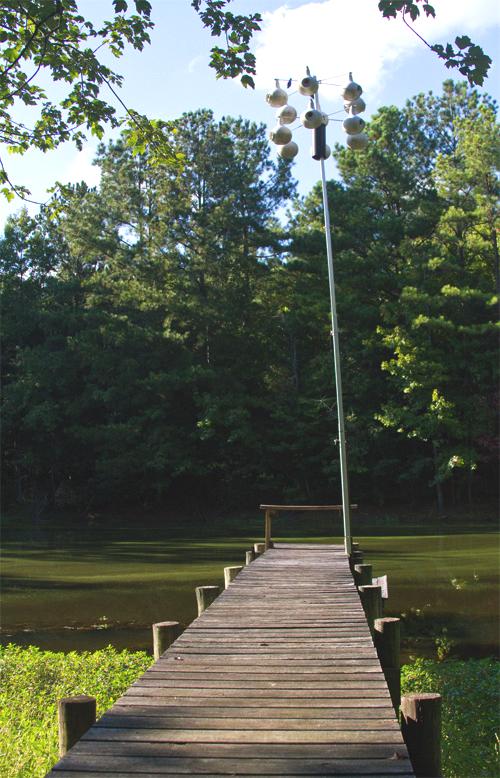
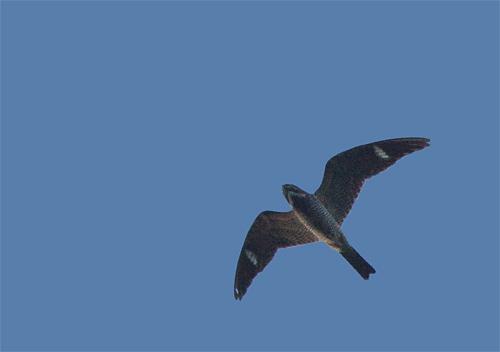
 Nighthawks, aren't flying mammals, either, despite an alternate nickname of "bullbat.") Growing up in Pittsburgh in the 1950s we watched nighthawks plying evening skies over the city but didn't know what they were at the time; we called them P-51 Mustangs (right) in honor of the World War II fighter planes made famous not too many years before.
Nighthawks, aren't flying mammals, either, despite an alternate nickname of "bullbat.") Growing up in Pittsburgh in the 1950s we watched nighthawks plying evening skies over the city but didn't know what they were at the time; we called them P-51 Mustangs (right) in honor of the World War II fighter planes made famous not too many years before.
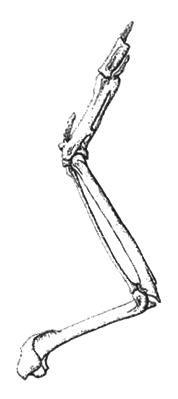 As we studied the image, however, we noticed something even more remarkable: The sunlight served almost like an X-ray by revealing the skeletal structure of the bird's wing! Clearly visible in the photo above is a relatively short upper wing bone (humerus) to which are attached the tertial flight feathers; the forewing that bears secondary feathers also shows--although the ulna and radius bones appear as one. Likewise in evidence is a structure most folks don't realize every bird actually has--a hand (manus)--but in birds the hand bones (carpals and metacarpals) are all fused and the fingers (phalanges) are vestigial. It is the bird's hand that supports the primary feathers with which birds can precisely control flight patterns. Silhouetted in the photo one can even see the egret's bony thumb that supports small alular feathers; the alula (AKA "bastard wing") helps keep birds from stalling during landings and slow flight. In our public lectures and workshops about hummingbirds we always talk in detail about how the human arm and a bird's wing are homologous and about which feathers are attached where; our backlit photo of the Great Egret over Hilton Pond provides a perfect demonstration of all this.
As we studied the image, however, we noticed something even more remarkable: The sunlight served almost like an X-ray by revealing the skeletal structure of the bird's wing! Clearly visible in the photo above is a relatively short upper wing bone (humerus) to which are attached the tertial flight feathers; the forewing that bears secondary feathers also shows--although the ulna and radius bones appear as one. Likewise in evidence is a structure most folks don't realize every bird actually has--a hand (manus)--but in birds the hand bones (carpals and metacarpals) are all fused and the fingers (phalanges) are vestigial. It is the bird's hand that supports the primary feathers with which birds can precisely control flight patterns. Silhouetted in the photo one can even see the egret's bony thumb that supports small alular feathers; the alula (AKA "bastard wing") helps keep birds from stalling during landings and slow flight. In our public lectures and workshops about hummingbirds we always talk in detail about how the human arm and a bird's wing are homologous and about which feathers are attached where; our backlit photo of the Great Egret over Hilton Pond provides a perfect demonstration of all this.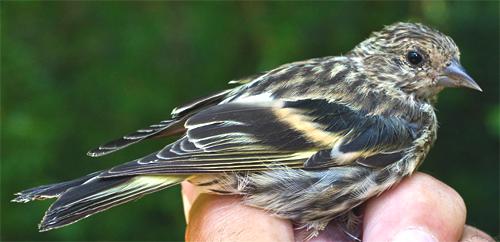
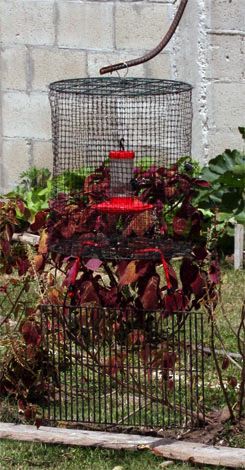 Our final bird encounter of the week involved a Ruby-throated Hummingbird--a species we concentrate on at Hilton Pond Center especially in August and the first half of September when we get our peak numbers. Each day during that period we typically deploy a few mist nets near the old farmhouse and almost always operate our now-favorite hummer trap--a cylindrical mesh contraption in which we hang a hummingbird feeder (right). We actually have five of these "Dawkins-style" traps that together in the past three years have captured more than three-quarters of all hummers we banded. The device is quite simple, with one low door that stays open. The hummer saunters in to feed, gets disoriented, flies up in the trap, and forgets how to get back down to the exit--the same thing that happens when a hummingbird comes in through your open garage door and eventually gets exhausted up in the rafters. Again, these Dawkins traps are visible from our computer desk so we can extricate a hummingbird as soon as it is caught.
Our final bird encounter of the week involved a Ruby-throated Hummingbird--a species we concentrate on at Hilton Pond Center especially in August and the first half of September when we get our peak numbers. Each day during that period we typically deploy a few mist nets near the old farmhouse and almost always operate our now-favorite hummer trap--a cylindrical mesh contraption in which we hang a hummingbird feeder (right). We actually have five of these "Dawkins-style" traps that together in the past three years have captured more than three-quarters of all hummers we banded. The device is quite simple, with one low door that stays open. The hummer saunters in to feed, gets disoriented, flies up in the trap, and forgets how to get back down to the exit--the same thing that happens when a hummingbird comes in through your open garage door and eventually gets exhausted up in the rafters. Again, these Dawkins traps are visible from our computer desk so we can extricate a hummingbird as soon as it is caught.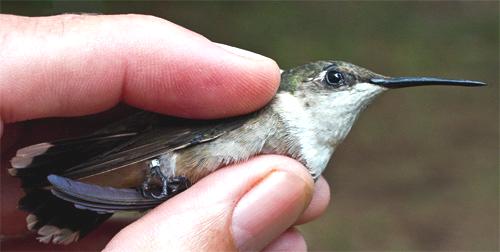


 Please report your
Please report your